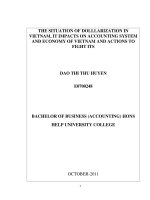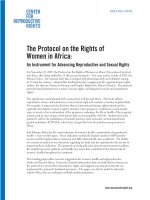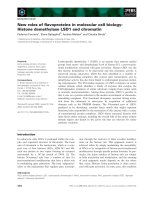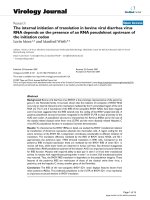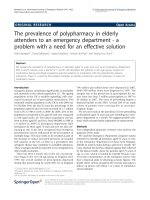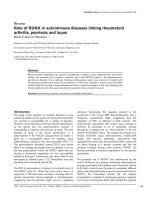Prevalence of salmonella in bovine fecal samples, slaughter house samples and environmental samples
Bạn đang xem bản rút gọn của tài liệu. Xem và tải ngay bản đầy đủ của tài liệu tại đây (239.64 KB, 9 trang )
Int.J.Curr.Microbiol.App.Sci (2019) 8(10): 352-360
International Journal of Current Microbiology and Applied Sciences
ISSN: 2319-7706 Volume 8 Number 10 (2019)
Journal homepage:
Original Research Article
/>
Prevalence of Salmonella in Bovine Fecal Samples, Slaughter House
Samples and Environmental Samples
R. Nethra1*, P. T. Ramesh2, B. M. Veeregowda3, C. Ansar Kamran1,
A. Muralidhara4 and M. L. Sathyanarayana5
1
Department of Veterinary Medicine, Veterinary College, Hebbal, Bengaluru, India
2
Peripheral Veterinary Hospital, Yelahanka, Bengaluru, India
3
IAH & VB, Bengaluru, India
4
Department of VCC, Veterinary College, Hebbal, Bengaluru, India
5
Department of Veterinary Pathology, Veterinary College, Hebbal, Bengaluru, India
*Corresponding author
ABSTRACT
Keywords
Bovine, PCR,
Prevalence,
Salmonella,
Slaughter house
Article Info
Accepted:
04 September 2019
Available Online:
10 October 2019
Salmonella is widely distributed in bovine in different countries and is considered the
most important related zoonotic diseases today which have a public health and
economic importance. The present study was conducted to survey the prevalence of
Salmonellosis in bovine fecal samples collected in ten different herds located at
relatively different geographical areas, slaughter house samples and environmental
samples by using standard microbiological and biochemical tests and confirm the
isolated Salmonella by polymerase chain reaction targeting invA gene, specific at
genus level. Six Salmonella isolates were recovered by screening 508 samples (388
bovine fecal samples from 10 different bovine herds, 57 lymphnode and gall bladder
samples from slaughter house, 63 environmental samples from the bovine herds and
Slaughter house) in the study. On an overall, the prevalence of Salmonella reported
was 1.2% (6/508). The herd prevalence in the study was 20% (2 out of 10 herds).
Whereas, the observed prevalence of Salmonella in bovine fecal samples, slaughter
house samples and environmental samples were 1.04%, 1.75% and 1.6%, respectively.
Polymerase chain reaction targeting invA gene confirmed the presence of Salmonella
in the samples positive for Salmonella by culture method.
Introduction
Salmonella infections are an important cause
of mortality and morbidity in subclinically
infected bovines. Bovines thus constitute an
important reservoir for human infections.
Interestingly, despite decades of research into
salmonellosis, the disease and its public health
consequences are not really resolved.
Salmonella is transmitted to animals and
humans through the fecal-oral route. Animals
352
Int.J.Curr.Microbiol.App.Sci (2019) 8(10): 352-360
can become infected after ingestion of feed
and water contaminated with Salmonella.
Similarly, humans can become infected by
food borne transmission (Hoelzer et al., 2011).
Also, Foodborne salmonellosis has been
traced to undercooked ground beef and other
beef products in the past, and lymph node
(LN) presence in the fatty tissues of beef
carcasses is one possible source of Salmonella
contamination (Rodriguez-Rivera et al.,
2014).
Bacterial isolation in culture media, followed
by serotyping is considered gold standard test
for confirmation of Salmonella. This is time
consuming and labour intensive. Therefore,
technique like Polymerase Chain Reaction
being used for rapid detection and
confirmation of Salmonella. Amplification of
invA gene of Salmonella has been reported as
a suitable target for PCR amplification, with
potential diagnostic applications (Mohler et
al., 2009).
The purpose of this study was to isolate and
investigate the prevalence of Salmonellosis in
bovine fecal samples, slaughter house samples
and environmental samples in bovine herds
within Karnataka.
Materials and Methods
In the present study the 10 randomly selected
bovine herds and slaughter house in Karnataka
were sampled.
Samples from bovine: Out of these 10 bovine
herds, a total of 388 fecal samples were
collected from all the animals. Approximately
10-20 grams of fecal samples were collected
by rectal retrieval using sleeves and placed in
labeled sterile plastic container.
Samples of slaughter house: 23 gall bladder
content samples and 34 lymphnodes like
subiliac, popliteal and mesenteric lymphnodes
were collected in sterile plastic bags separately
and water sample in sterile screw capped glass
tube.
Samples from environment: From each herd
10-20 grams of sample of feed, soil and slurry
were collected in separate plastic containers.
Sterile swabs were used for sample collection
from floor and manger in each farm, before
which they were presoaked in sterile
phosphate buffer saline. The sample from each
floor and manger was collected by wiping it
for ten meter and placed into sterile plastic bag
containing PBS. About 20 ml of drinking
water (tap /bore well/ pond water) from each
herd and slaughter house were collected in
labeled sterile screw capped glass tubes.
Culture method: Faecal samples, feed
samples, slurry, soil and rodent droppings
were tested by mixing one gram sample in 10
ml buffered peptone (pre enrichment) water
and incubated for 37◦C in incubator for 12-16
hrs. One ml of grown aliquots was transferred
to 10ml Rappaport and Vassiliadis (RV)
medium and incubated at 42◦C for 24 hours in
incubator and subsequently plated on to agar
plates. Aliquots of the incubated broth culture
were plated on Mac Conkey agar, XLD agar
and Xylose-lysine tergitol-4 (XLT-4 agar)
agar plates and incubated at 37◦C for 24-48
hours. The colonies showing typical characters
were
selected
for
biochemical
characterization. The collected drinking water
samples from the herds and slaughter house
were cultured by adding 10 ml sample to 100
ml of double strength enrichment broth (RV
medium) followed by incubation and sub
cultured on selective media as described
above. The floor swabs and manger swabs
were placed in 250-500 ml of enrichment
broth and followed by incubation and subcultured on selective media as described
above.
Biochemical
characterization:
Suspicious colonies were inoculated on to
triple sugar iron (TSI) agar slants and
353
Int.J.Curr.Microbiol.App.Sci (2019) 8(10): 352-360
incubated for 18-24 hours at 37◦C. The isolates
showing reaction typical of Salmonella were
further tested by urease test, sulfide indole
motility test and phenyl alanine agar test.
Polymerase Chain Reaction: Culture isolated
and biochemically identified Salmonella
isolates were confirmed further by more
specific molecular technique, PCR targeting
genus specific InvA gene.
positive for Salmonella spp. on bacterial
culture and identification by biochemical
characters. Whereas no organisms were
recovered from gall bladder samples and the
three bore well water samples at the slaughter
houses. Approximately 1.7% of the slaughter
house samples were positive for Salmonella
spp. (Table 3).
Identification of Salmonella by biochemical
characterization
Results and Discussion
Bacterial isolation
In the present study, a total of 388 fecal
samples from ten herds in and around
Bengaluru
viz
ILFC
Bengaluru,
Chickaballapura, Yenigadale, Ganjigunte,
Rachahalli,
Byappanahalli,
Bashetahalli,
Shidlagata, Upparahalli and Gauribidanur and
63 environmental samples involving feed,
slurry, rodent droppings, soil and drag swabs
each from every farm and water from 10 farms
and slaughter houses were cultured for
Salmonella.
On culture two calves out of 52, one heifer out
of 108 and one lactating animal out of 228
were positive for Salmonella. Whereas one
water sample was found positive among 63
environmental samples collected. The
prevalence of Salmonella was 5.0%, 0.0%,
0.0%, 5.9%, 0.5% and 0.0% in cattle calves,
buffalo calves, cattle heifers, buffalo heifers,
lactating cattle and lactating buffalo
respectively (Table 2). Approximately 1.04%
(4 of 388) of the total fecal samples (Table 1)
and 1.6% of the total environmental samples
(Table 4) were positive for Salmonella.
Out of 10 subiliac lymphnodes, 6 femoral
lymphnodes, 4 popliteal lymphnodes, 14
mesentric lymphnodes and 23 gall bladder
samples collected from the slaughter houses
one mesentric lymphnode sample yielded
On microbiological analysis of 508 samples,
86 samples revealed presumptive Salmonella
colonies on XLT4 agar plate. Further, on
biochemical characterization, 6 samples
revealed biochemical profile suggestive of
Salmonella genus.
Polymerase Chain Reaction
All six isolates were visualized by UV
illumination which showed the expected bands
of about 284 bp (Figure 1). The method of
PCR demonstrated the specificity of invA
primers for detection of Salmonella in the
fecal, slaughter house and environmental
samples after culture enrichment.
In the present investigation, a total of 508
samples (388 fecal, 34 LN, 23 Gall bladder
and 63 environmental samples) were screened
for Salmonella by culture method. The 86
presumptive Salmonella colonies were further
characterized on the basis of biochemical
characters. Six Salmonella isolates were
identified
based
on
biochemical
characterization.
Herd prevalence of Salmonella
In the present investigation, a total of ten
herds were screened for Salmonella, from
which 388 fecal samples and 60
environmental samples were collected and 2
(20%) herds were found to be positive. The
354
Int.J.Curr.Microbiol.App.Sci (2019) 8(10): 352-360
results indicated that prevalence of Salmonella
in herds of Karnataka was 20%. The herd
prevalence reported in the present study was
lower than some studies of Salmonella in
dairy animals where it was reported as 43% by
Callaway et al., (2005), 40% by Bhoyar
(2009) in Punjab, 28% by Wells et al., (2001)
in US and 31% by Huston et al., (2002) in
Ohio dairy farms. The difference in the
prevalence of Salmonella in animals of
various geographical areas may be due to
difference in management, barn sectioning,
herd size, feeding strategies and concurrent
infections (Neilson et al., 2004) and host
related risk factors that include age, breed, the
physiological state of the animals, feeding
strategies, vaccination status.
Prevalence of Salmonella in bovines
The prevalence of bovine fecal salmonellosis
recorded was 1.04%. This observation was in
accordance with Williams et al., (1978),
Dargatz et al., (2000), Mc Evoy et al., (2003)
and Lombard et al., (2012). While the
prevalence of present study was lower than
that reported by Huston et al., (2002).
Fossler et al., (2004), Younis et al., (2009),
Addis et al., (2011), Youssef and El-Haig
(2012) and El-Seedy et al., (2016). On
contrary, this result was higher than that
reported by Opuda-Asiba et al., (1990), Gay et
al., (1994), Van Donkersgoed et al., (1999),
Alemayehu et al., (2003) and Davies et al.,
(2004).
Fricker (1987) elucidated that lower
prevalence might be due to less number of
colony forming units of bacteria which were
below the detection limit of the assay
(especially in case of Salmonella in feces). On
the other hand, it is also plausible that some
animals with a positive Salmonella culture
result and compatible clinical signs were
actually symptomatic because of another
primary disease process; this would lead to an
overestimation
of
the
incidence
of
salmonellosis. Additionally, the presence of
antibiotic residues may explain falsely
negative bacteriological results because the
withdrawal time is not regarded in our herds.
Prevalence of Salmonella in Slaughter
house
The prevalence of Salmonella in gall bladder
was 0% and 2.94% from the lymphnodes in
slaughter houses. The organism was isolated
from mesenteric LN. Salmonella enters the
animal and then is captured within the
lymphnodes. The observation of the present
study was in accordance with Kore et al.,
(2017). Whereas Beyene et al., (2016)
observed higher prevalence of Salmonella in
mesenteric lymphnodes and reported as 13%.
One possible explanation is that it escapes the
gastrointestinal tract and enter mesenteric
lymph nodes, and then disseminates
systemically.
Additionally, epidemiological patterns of
Salmonella
differ
greatly
between
geographical areas depending on climate, food
harvesting and processing technologies and
consumer habits.
Hanson et al., (2016) reported evidence for
vertical transmission from the dam to her
fetus. Further, serotypes recovered mesenteric
lymph nodes more closely resemble those
recovered from the feces [15].
One among 57 samples of slaughter houses
was positive for Salmonella and the
prevalence recorded was 1.75% in slaughter
house. The observations were in accordance
with Webb et al., (2017). The reason could be
associated with the hygienic status of the
abattoir and cross contamination among the
materials used in the slaughtering operation
and processing of food might be less.
355
Int.J.Curr.Microbiol.App.Sci (2019) 8(10): 352-360
Table.1 Prevalence of Salmonella spp in faecal samples of bovine herds by isolation and
biochemical characterization
Bovine
Herd
1
2
3
4
5
6
7
8
9
10
Calves (1-6)
months
No. of samples
Tested Positive
6
0
3
0
4
0
5
0
7
1
6
1
5
0
4
0
6
0
6
0
52
2
Bovine fecal samples
Heifers
Lactating animals
No. of samples
Tested Positive
24
0
5
0
10
0
8
0
9
0
13
0
11
0
10
0
11
1
7
0
108
1
No. of samples
Tested Positive
53
0
16
0
16
0
15
0
21
1
23
0
20
0
16
0
27
0
21
0
228
1
Total
samples
Total
positive
samples
83
24
30
28
37
42
36
30
44
34
388
0
0
0
0
2
1
0
0
1
0
4
Table.2 Age wise prevalence of Salmonella spp in cattle and buffao herds.
Calves
Heifers
Lactating
Cattle
Buffalo
Cattle
Buffalo
Cattle
Buffalo
No. of fecal samples
40
14
84
17
197
31
388
No. of positive samples
2
0
0
1
1
0
4
Prevalence (%)
5.0
0.0
0.0
5.9
0.5
0.0
1.04
No. of samples
Interval 1
Interval 2
Interval 3
Teste
d
7
11
16
34
Positive
0
1
0
1
0.0
5.2
0.0
2.94
Gall bladder
No. of samples
Teste
d
5
8
10
23
Positive
0
0
0
0
356
Tested
Positive
0.0
0.0
0.0
0.0
12
19
26
57
0
1
0
1
Total no. of
samples
Prevalence (%)
Lymphnodes
Prevalence (%)
Slaughter
House
Prevalence (%)
Table.3 Isolation and characterization of Salmonella spp from Slaughter house samples.
0.0
5.2
0.0
1.75
Int.J.Curr.Microbiol.App.Sci (2019) 8(10): 352-360
Table.4 Prevalence of Salmonella in environmental samples
Water
No. of samples
Other environmental samples
Total number of
samples
Feed
Rodent
Slurry Soil
Drag
droppings
swab Positive
Tested
Tested Tested Tested
Tested Positive
Tested Positive Tested
13
1
(7.7%)
10
10
10
10
10
0
63
1
(1.6%)
Fig.1 The PCR amplification of invA gene of Salmonella serovars (isolated from bovine fecal
samples and Slaughter house samples) showing positive amplicons at 284 bp. DNA size marker
(M). Lane 1: negative control Lane 2 to 7: Salmonella positive
M
1
2
3
Environmental prevalence of Salmonella
Salmonella, although being intestinal bacteria,
are widespread in the environment and are
commonly found in farm effluents and in any
material subjected to fecal contamination [24].
Identification of Salmonella reservoirs is
critical for understanding its dissemination in
the environment.
In the present investigation the environmental
samples yielded 1.6% prevalence of
Salmonellosis. The environmental prevalence
in the present study was higher than
prevalence of Salmonellosis from bovine fecal
shedding.
4
5
6
7
The findings suggest that sources other than
farm animals may be a contributor to
Salmonella in the farming environment. The
results were in accordance with Warnick et
al., (2001), Fossler et al., (2004) and Gorski et
al., (2011).
Whereas all the other environmental samples
collected in the present were negative for
Salmonella organisms which might be due to
fecal shedding of the organism is
intermittently variable and the collected
sample might not have contained the
pathogen.
357
Int.J.Curr.Microbiol.App.Sci (2019) 8(10): 352-360
Confirmation of the isolates by Polymerase
Chain Reaction
The results demonstrated a correct genus
identification of examined Salmonella
isolates. These results were similar to those
obtained by Nair et al., (2009), Kaushik et al.,
(2014) and El-Seedy et al., (2016) confirmed
the Salmonella isolates by proving the PCR
test to be more specific and also a rapid test.
Salmonella invA gene has become one of the
most popular PCR target sequences and its
amplification now has been recognized as an
international standard for detection of
Salmonella. Despite the challenges and limits
of this study, it is clear that Salmonella is
present in bovines in the study area at
prevalence rate of 1.04%. Moreover, the
prevalence of Salmonellosis is to some extent,
associated with farm management practices.
Salmonellosis is important zoonotic infection
and reducing the prevalence within and
between herds would benefit the human
population directly as well as allow for
healthier livestock.
References
Abe Kebede, Jelalu Kemal, Haile Alemayehu
and Solomon Habte Mariam, 2016.
Isolation, Identification, and Antibiotic
Susceptibility Testing of Salmonella
from Slaughtered Bovines and Ovines
in Addis Ababa Abattoir Enterprise,
Ethiopia: A Cross-Sectional Study. Int.
J. of Bact. 2016:1-8.
Addis, Z., Nigatu K., Zufan. S., Haile. A.,
Alehegne, Y. and Tesfu, K. 2011.
Prevalence
and
antimicrobial
resistance of Salmonella isolated from
lactating cows and in contact humans
in dairy farms of Addis Ababa: a cross
sectional
study.
BMC
Infect.
Dis.11:222.
Alemayehu, D., Molla, B. and Muckle, A.
2003. Prevalence and Anti Microbial
Resistance in Salmonella from cattle in
Ethiopia. Trop. Anim. Hlth. Prod. 35:
309-319.
Beyene, T., Yibeltie, H., Chebo, B., Abunna,
F., Beyi, A. F., Bedaso Mammo,
Ayana D. and Reta, D. 2016.
Identification
and
Antimicrobial
Susceptibility Profile of Salmonella
Isolated from Selected Dairy Farms,
Abattoir and Humans at Asella Town,
Ethiopia. J. Vet. Sci. Techno.7:3.
Callaway, T. R., Keen, J. E., Edrington, T. S.,
Baumgard, L. H., Spicer, L., Fonda, E.
S., Griswold, K. E., Overton, T. R.,
Vanamburgh, M. E., Anderson, R. C.,
Genovese, K. J., Poole, T. L., Harvey,
R. B. and Nisbet, D. J. 2005. Fecal
prevalence and diversity of Salmonella
species in lactating dairy cattle in four
states. J. Dairy Sci. 88(10):3603-3608.
Dargatz, D.A., Fedorka-Cray, P.J., Ladely,
S.R. and Ferris, K.E., 2000. Survey of
Salmonella serotypes shed in feces of
beef cows and their antimicrobial
susceptibility patterns. Journal of food
protection, 63(12): 1648-1653.
Davies, R.H., Dalziel, R., Gibbens, J.C.,
Wilesmith, J.W., Ryan, J.M., Evans, S.
J., Byrne, C., Paiba, G.A., Pascoe,
S.J.S. and Teale, C.J., 2004. National
survey for Salmonella in pigs, cattle
and sheep at slaughter in Great Britain
(1999-2000). J. Appl. Microbiol.,
96:750-60.
El-Seedy, F.R., Abed, A.H., Yanni, H.A. and
El-Rahman, S.A., 2016. Prevalence of
Salmonella and E. coli in neonatal
diarrheic
calves. Beni-Suef
University.J. Of Basic and Appl.
Sci,. 5(1): 45-51.
Fossler, C.P., Wells, S.J., Kaneene, J.B.,
Ruegg, P.L., Warnick, L.D., Bender,
J.B., Godden, S.M., Halbert, L.W.,
Campbell, A.M. and Zwald, A.M.G.,
2004. Prevalence of Salmonella spp on
358
Int.J.Curr.Microbiol.App.Sci (2019) 8(10): 352-360
conventional and organic dairy
farms. JAVMA. 225(4): 567-573.
Fricker, C.R., 1987. A Review. The isolation
of salmonellas and campylobacters. J.
Appl. Bact.,63:99-116.
Gay, J.M., Rice, D.H. and Steiger, J.H., 1994.
Prevalence of fecal Salmonella
shedding by cull dairy cattle marketed
in
Washington
State. J
food
prot. 57(3):195-197.
Gorski, L., Parker, C.T., Liang, A., Cooley,
M.B., Jay-Russell, M.T., Gordus,
A.G., Atwill, E.R. and Mandrell, R.E.,
2011. Prevalence, distribution, and
diversity of Salmonella enterica in a
major
produce
region
of
California. Appl. Environ. Microbiol.
77(8): 2734-2748.
Gragg, S.E., Loneragan, G.H., Nightingale,
K.K., Brichta-Harhay, D.M., Ruiz, H.,
Elder, J.R., Garcia, L.G., Miller, M.F.,
Echeverry, A., Porras, R.G.R. and
Brashears, M.M., 2013. Substantial
within-animal diversity of Salmonella
isolates from lymph nodes, feces, and
hides of cattle at slaughter. Appl.
Environ. Microbiol. 79(15): 47444750.
Hanson, D.L., Loneragan, G.H., Brown, T.R.,
Nisbet, D.J., Hume, M.E. and
Edrington, T.S., 2016. Evidence
supporting vertical transmission of
Salmonella in dairy cattle. Epidemiol.
and Infect. 144(5):.962-967
Hoelzer K, Moreno Switt A.I. and Wiedmann
M., 2011. Animal contact as a source
of human non-typhoidal salmonellosis.
Vet. Res.,42:34
Huston, C.L., Wittum, T.E., Love, B.C. and
Keen, J.E., 2002. Prevalence of fecal
shedding of Salmonella spp in dairy
herds. JAVMA. 220(5): 645-649.
Karin, H., Andrea, I. M. and Martin, W., 2011.
Animal contact as a source of human
non-typhoidal salmonellosis. J. Vet.
Res.42: 1-28.
Kaushik, P., Kumari, S., Bharti, S.K. and
Dayal, S., 2014. Isolation and
prevalence of Salmonella from chicken
meat and cattle milk collected from
local markets of Patna, India. Vet.
World. 7(2): 62-5.
Kore, K., Asrade, B., Demissie, K. and
Aragaw, K., 2017. Characterization of
Salmonella isolated from apparently
healthy slaughtered cattle and retail
beef
in
Hawassa,
southern
Ethiopia. Prev. Vet. Med. 147: 11-16.
Lombard, J.E., Beam, A.L., Nifong, E.M.,
Fossler, C.P., Kopral, C.A., Dargatz,
D.A., Wagner, B.A., Erdman, M.M.
and
Fedorka-Cray,
P.J.,
2012.
Comparison of individual, pooled, and
composite fecal sampling methods for
detection of Salmonella on US dairy
operations. J. food Prot. 75(9):15621571.
Malorny, B., Hoorfar, J., Bunge, C. and
Helmuth, R., 2003. Multicenter
validation of the analytical accuracy of
Salmonella
PCR:
towards
an
international standard. Appl. Environ.
Microbiol. 69(1): 290-296.
Martinez-Urtaza, J., Saco, M., De Novoa, J.,
Perez-Piñeiro, P., Peiteado, J., LozanoLeon, A. and Garcia-Martin, O., 2004.
Influence of environmental factors and
human activity on the presence of
Salmonella serovars in a marine
environment. Appl.
Environ.
Microbiol. 70(4): 2089-2097.
Mcevoy, J.M., Doherty, A.M., Sheridan, J.J.,
Blair, I.S. and Mcdowell, D.A., 2003.
The prevalence of Salmonella spp. in
bovine faecal, rumen and carcass
samples at a commercial abattoir. J. of
Appl. Microbiol. 94(4): 693-700.
Mohler, V. L., Izzo, M. M. and House, J. K.,
2009. Salmonella in calves. Vet. Clin.
North Am. Food Anim. Pract. 25(1):
37-54.
359
Int.J.Curr.Microbiol.App.Sci (2019) 8(10): 352-360
Nair, A., Balasaravanan, T., Malik, S.S.,
Mohan, V., Kumar, M., Vergis, J. and
Rawool, D.B., 2015. Isolation and
identification of Salmonella from
diarrheagenic infants and young
animals, sewage waste and fresh
vegetables. Vet. World, 8(5): 669-673.
Nielsen, L.R., Schukken, Y.H., Gröhn, Y.T.
and Ersbøll, A.K., 2004. Salmonella
Dublin infection in dairy cattle: risk
factors for becoming a carrier. Prev.
Vet. Medi, 65(1-2):47-62.
Opuda-Asibo, J., Robinson, R.A. and Pullen,
M.M., 1990. Prevalence of Salmonella
in
healthy
calves
following
transportation to the stockyards and at
slaughter. Bull. Anim. Healt. and Prod.
Afr. 38(1), pp.101-102.
Rodriguez-Rivera, L.D., Wright, E.M., Siler,
J.D., Elton, M., Cummings, K.J.,
Warnick, L.D. and Wiedman, M.,
2014. Subtype analysis of Salmonella
isolated from subclinically infected
dairy
cattle
and
dairy
farm
environments reveals the presence of
both human-and bovine-associated
subtypes. Vet.
Microbiol. 170(3-4):
307-316.
Van Donkersgoed, J., Graham, T. and
Gannon, V., 1999. The prevalence of
verotoxins, Escherichia coli O157: H7,
and Salmonella in the feces and rumen
of cattle at processing. The Canadian
Vet. J., 40(5): 332–338.
Warnick, L.D., Crofton, L.M., Pelzer, K.D.
and Hawkins, M.J., 2001. Risk factors
for clinical salmonellosis in Virginia,
USA
cattle
herds. Prev.
Vet.
Med., 49(3-4): 259-275.
Webb, H.E., Brichta-Harhay, D.M., Brashears,
M.M., Nightingale, K.K., Arthur,
T.M., Bosilevac, J.M., Kalchayanand,
N., Schmidt, J.W., Wang, R., Granier,
S.A. and Brown, T.R., 2017.
Salmonella in peripheral lymph nodes
of healthy cattle at slaughter. Frontiers
in Microbial., 8: 2214.
Williams, D.R., Bellhouse, R. and Davidson,
C.L., 1978. The prevalence of
salmonellae in healthy cattle at
slaughter. Vet. Rec. (UK).
Younis, E.E., Ahmed, A.M., El-Khodery,
S.A., Osman, S.A. and El-Naker, Y.F.,
2009. Molecular screening and risk
factors of enterotoxigenic Escherichia
coli and Salmonella spp. in diarrheic
neonatal calves in Egypt. Res. in
Vet.Sci., 87(3): 373-379.
Youssef, A.I. And El-Haig, M.M., 2012. Herd
problems and occupational zoonoses of
Salmonella
enterica
serovars
Typhimurium and Enteritidis infection
in diarrheic cattle and buffalo calves in
Egypt. Hum. Vet. Med., 4(3): 118-123.
How to cite this article:
Nethra, R., P. T. Ramesh, B. M. Veeregowda, C. Ansar Kamran, A. Muralidhara and
Sathyanarayana, M. L. 2019. Prevalence of Salmonella in Bovine Fecal Samples, Slaughter
House Samples and Environmental Samples. Int.J.Curr.Microbiol.App.Sci. 8(10): 352-360.
doi: />
360

